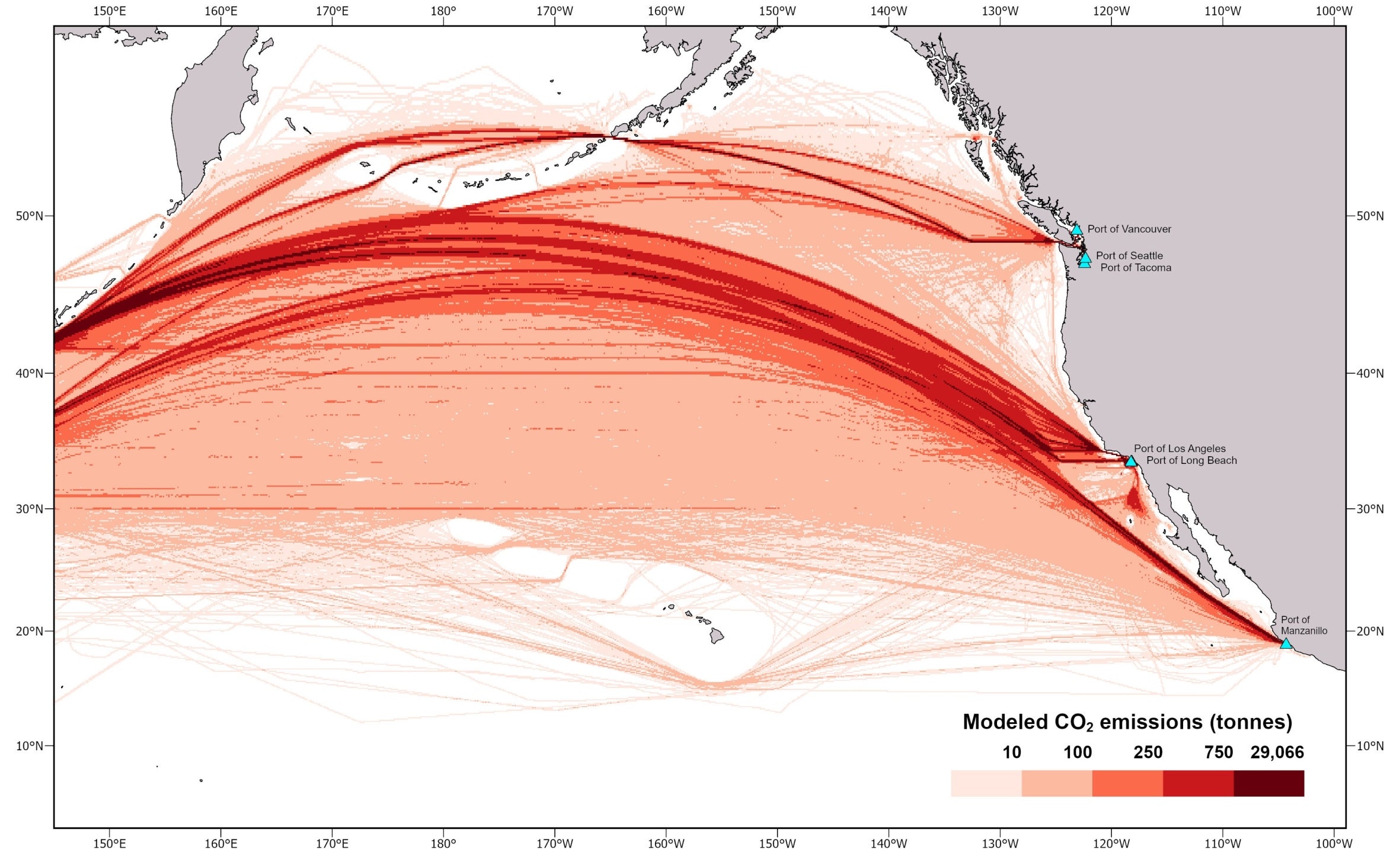
A cheap and easy potential solution for lowering carbon emissions in maritime shipping
Adopting new digital systems to help oceangoing container ships get in line to offload their cargo at busy ports appears to reduce greenhouse gas (GHG) emissions by 16-24%, according to researchers at UC Santa Barbara. Not only would this relatively simple intervention reduce emissions, but the technology to implement these measures already exists and is cheap.
“Arguably the most impactful thing we can do to slow climate change is to directly cut CO2 emissions,” said Rachel Rhodes, a project scientist at the Benioff Ocean Science Laboratory (BOSL) at UCSB, and lead author of a paper that appears in the journal Marine Pollution Bulletin. “This has scientists looking at all sectors for places to trim.”
One promising candidate for CO2 reduction is the maritime shipping industry, which contributes about 3% of the world’s total greenhouse gases — on par with emissions from aviation — an amount that is forecasted to grow as globalization increases. Typically, these vessels race across the ocean and then line up and idle at ports as they wait to be unloaded.
“Many ports worldwide still use the century-old ‘first come, first-served’ system for ship berthing, that reminds me of when you pull a ticket from those red ‘take a number’ machines when you visit the Department of Motor Vehicles,” said Douglas McCauley, a UCSB marine ecologist and director of the BOSL. In normal times at the Ports of Los Angeles and Long Beach, this system typically results in a backlog of 0-4 container vessels waiting to be unloaded. During disruptions, such as the delays brought by the COVID pandemic, the inefficiency can increase to around 100 container vessels just idling near the port.
During the pandemic, marine industry stakeholders came together to quickly design and implement a new electronic queueing system primarily to prevent such congestion. Herein lies the potential low-hanging fruit.
“Instead of using the old approach, container ships get a spot in line based on when they left their previous port,” said Rhodes. “Think of it like making a reservation at a popular restaurant before you leave home, rather than racing across town, hoping to beat others to the door.” With their place in line secure, vessels delivering cargo to Los Angeles/Long Beach don’t have to rush during their trans-Pacific voyage. In theory, these slower ships would burn less fuel and create fewer emissions.
While the vessel queueing system was originally developed for the purpose of eliminating the bottleneck at the twin ports, Rhodes, McCauley and other collaborators from UCSB, NOAA, the California Marine Sanctuary Foundation, the marine exchanges of Alaska and Southern California, and Global Fishing Watch suspected it might have the added benefit of reducing CO2 emissions.

To find out, the researchers analyzed more than 47 million miles of traffic crossing the Pacific, spread over 10,000 voyages by 1,157 container ships from 2017-2023. Using a bottom-up approach, they calculated the emissions generated by container vessels before and after the queueing system’s 2021 implementation.
They found that this simple change appeared to make a big difference, with apparent reductions of 16-24% less CO2 pollution produced per trip, after the new system was implemented.
“Without needing to ‘hurry up and wait’ to secure their spot in line, ships are saving fuel by traveling at slower, more efficient speeds,” McCauley said. “Just like how your car gets much better gas mileage when you drive 65 mph instead of 85 mph.”
The queueing system, conducted by Pacific Maritime Management Systems — a partnership between the Marine Exchange of Southern California and the Marine Exchange of Alaska — can serve as a model for other ports around the world that are or could be facing congestion as demand rises for goods in an increasingly globalized economy, according to the researchers. Its built-in resilience mechanism can help these ports maintain operations during times of disruption, while lowering CO2 emissions at a source. What’s more, implementation of this system is quick.
“Unlike technological solutions that require significant investment and time, this operational innovation was designed and implemented at the world’s ninth busiest port complex within just one month of the working group convening, showing how rapid changes are possible,” Rhodes noted. “The success relied heavily on the coordination capabilities and digital infrastructure provided by PacMMS, as well as the active participation of vessels and carrieres whose willingness to comply with the new protocols was crucial.”
The time is ripe, the researchers say, for ports around the world to adopt digital queueing, an easy, cost-effective way to modernize while also working toward better air quality along the world’s coasts.
“Integrating digital queueing represents a straightforward win within the broader technology and digital transformation initiatives that ports and logistics companies are already pursuing, offering an easy-to-implement solution that could scale globally as ports modernize and streamline their operations to reduce emissions,” McCauley said. “If similar benefits are demonstrated at other ports, these systems could offer a relatively simple pathway for the maritime industry to contribute to emissions reduction efforts.
Reducing cargo vessel speeds would also greatly benefit the creatures that share our shipping lanes: whales. Research conducted by the same UCSB lab has found that slower ships have fewer lethal collisions with endangered whales, making this intervention a potential win for them too.
Looking ahead, the researchers continue to investigate more ways to reduce carbon emissions at shipping ports. Comparing emissions between the twin LA/LB ports and others on the West Coast that had not yet adopted the new system, they found that the other ports also had indications of more moderate emissions reductions, a reminder that other key factors exist that shape ship speed and emissions. Properly identifying these systemic factors could help further drive down emissions in addition to slower speeds and intelligent queuing.
Additional fine tuning of the queueing system may also yield even bigger climate wins, say the researchers.
“For example, tweaking the system slightly so ships travelled at an average speed of 17 instead of 18 knots across the Pacific appears to have the capacity to shave off another approximately 308,000 tons of CO2 emissions — that’s an additional 9% reduction,” said McCauley. “While travelling at marginally slower speeds is not always feasible for all types of shipping today, these early insights can help us contemplate ways to reduce both climate impact and improve operational efficiency in the future if the industry trends toward more digitization in the ports, automation fleets and more AI-connected supply chains that accurately anticipate market trends and shipping needs.”
The team looks forward to applying these types of research insights to helping envision a greener, more efficient and cost-effective future for the shipping industry and ports.
Research in this paper was also conducted by Callie Leiphardt and Hillary Young at UCSB; Jessica Morten at the Channel Islands National Marine Sanctuary; Byron Hayes and Jen Dillon at the Marine Exchange of Alaska; Wendy Louttit at the Marine Exchange of Southern California and Mark Powell at Global Fishing Watch.



